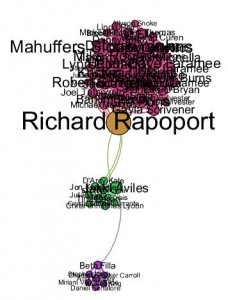 There’s a bit of buzz about whether prospect research is going to get dumbed down by smart software products or if it will get lifted into the realm of strategy and management. The reality is probably a bit of both. Today I thought I’d bite off one little piece of the bigger conversation. I want to take a tried and true prospect research task – the trusty profile – and toss it up in the air to discover a new perspective on its utility and value.
There’s a bit of buzz about whether prospect research is going to get dumbed down by smart software products or if it will get lifted into the realm of strategy and management. The reality is probably a bit of both. Today I thought I’d bite off one little piece of the bigger conversation. I want to take a tried and true prospect research task – the trusty profile – and toss it up in the air to discover a new perspective on its utility and value.
Conversation Starter
Sabine Schuller jump-started the dialogue on the PRSPCT-L list-serv with an article,Is a Googlized Workplace Replacing Dedicated Competitive Intelligence Resources? Substitute “prospect research” for “competitive intelligence” and you can join in the exchange. Helen Brown did! She opined on the topic with a blog post, Prospect Research’s Strategic Advantage, suggesting that prospect researchers offer “experience, context, and strategy”. Mark Noll and Chris Mildner commented about the need for prospect research to concern itself with ROI. They told us we have to demonstrate how research translates into increased gift levels.
Can We Re-Wire the Humble Profile?
As you might have noticed, the topic has many layers of discussion points and profiles are somewhere amongst them. Can we re-wire the humble profile to make it more strategic and cost efficient? What does that mean?
I’ve heard conversations along these lines:
- The paper profile is dead. It should all go into the database.
- Research should be finding the basics – ability, inclination, linkage/affinity – and spend not a minute more.
- My gift officer was struggling to connect with a prospect and I dug deep and found some nuggets of interest that helped him to solicit and receive a multi-million dollar gift.
My two cents? They are all correct! Prospect research is positioned differently at each organization depending upon the structure and culture of its fundraising operations. But sometimes people are so excited about their success with their hammer that they begin to view every problem as a nail, even if it’s a screw.
My favorite type of client to work with has no research staff and is tasked with raising million-dollar gifts. She relies on the paper profiles to give her really deep insight into what makes this prospect tick because the pressure is high to get the largest gift possible for her organization. She doesn’t hesitate to call me and question the information so she can feel confident in her ask amount.
It’s my job to know how much and what kind of detail to include.
That’s a big sentence. And it leads me to an interesting interaction I had recently with another client. We were talking about her need for corporate research. She wanted all the usual info, but they had specific strategies they were focused on for corporate prospects. My profiles are typically organized to best present the information collected, but what I was hearing was that she wanted to know exactly how to approach the company for each strategy.
So I reorganized the profile to highlight info relevant to each strategy first and then other sections to hold traditional, but necessary, information second. I did the first couple of profiles to be sure it worked and, well, it felt awkward. It took extra effort to parse the information into the right spots. I truly had to think first about the strategy and second about the information I was scanning. But it kept the profile laser-focused on what was most important to creating the cultivation and solicitation strategy. That felt good!
But, What About You and Your Office?
When deciding how much and what kind of profile types your prospect research department should be producing, I recommend engaging your fundraising staff in dialogue around these big questions:
Does everyone understand…
- What the three main functions of prospect research areas are? (Prospect Identification or proactive, Prospect Profiling or reactive, and Relationship Management)
- How those functions affect and support their specific specialty (events, annual fund, major and planned gifts, alumni relations, etc.)?
- Where they fit within the strategic goals for the organization’s overall fundraising?
(Just remember that, as in search technique, less is often more. We’re not talking two weeks of training, but a simple, framework discussion.)
With everyone on the same page, now you can begin to have a discussion about things like if and when prospect research should be doing in-depth, six to twelve hour individual research profiles or who should be preparing bullet points for major gift prospects at events.
Now everyone knows where the priorities lie and how prospect research is going to be used to support them. It might not make everyone happy, but hey, happiness is a personal journey, right?
Onward to the Future!
Yes, the world is a-changing. We need to have the confidence and courage to re-engineer our services. We need to become more competitive and tie what we do to its impact on giving. And as we pursue big-picture discussions about the future of our profession, we need to recognize the diversity of our experience, context and strategies to create best practices focused on problem-solving.
With professionals like Sabine Schuller, Helen Brown, Mark Noll, Chris Mildner and You, I have no doubt we can ride these waves of changes with aplomb. I can’t wait to hear what you have to say!










